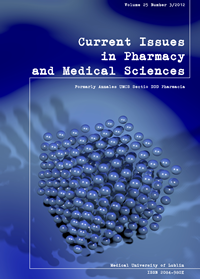Formulation and stability evaluation of hydrogels with ketoconazole
DOI:
https://doi.org/10.12923/j.2084-980X/25.3/a.12Keywords:
ketoconazole, hydrogel, Carbopol 980, HEC, stabilityAbstract
This study is focused on designing hydrogels with ketoconazole (KET) based on two polymers - Carbopol 980 or hydroxyethyl cellulose (HEC). Hydrogels were stored for 6 months at different temperature and relative humidity conditions (4ºC ± 2ºC, 25ºC ± 2ºC and 60% ± 5% RH, 40ºC ± 2ºC and 75% ± 5% RH). It was found that hydrogels made of Carbopol 980 exhibited more favourable physicochemical properties and better stability . In HEC hydrogels stored at 40ºC ± 2ºC and 75% ± 5% RH a decrease of pH, differences in the content and sedimentation of KET were observed. In vitro release study showed that amount of released KET from designed hydrogels was definitely higher than from registered product.
References
1. Bouwstra J. A., Junginger H. E.: Hydrogels. Encyclopedia of Pharmaceutical Technology, 1st ed., Swarbrick J., Boylan J. C., New York, 7, 441, 1993.
2. European Pharmacopoeia, 7 ed., vol. 2, Council of Europe, Strasbourg 2011.
3. Gil C., Perez - Diaz R., Nombela C.: Inhibitory and morphological effects of several antifungal agents on three types of Candida albicans morphological mutants. J. Med. Vet. Mycol., 32, 151, 1994.
4. Kauffman A., Carver P.: Use of azoles for systemic antifungal therapy. Adv. Pharmacol., 39, 147, 1997.
5. Kovács K., Stampf G., Klebovich I., Antal I., Ludányi K.: Aqueous solvent system for the solubilization of azole compounds. Europ. J. Pharm. Sci., 36, 352, 2009.
6. Kshirsagar N. A.: Drug delivery systems. Ind. J. Pharmacol. 32, 54, 2000.
7. Loganathan V., Jaswanth A., Sulaiman A., Rajaseskaran A., Manimaran S., Kumar S.B.: The effects of polymers permeation enhancers on release of flurbiprofen from gel formulation. Indian J. Pharm. Sci., 63, 200, 2001.
8. Musiał W., Kubis A.: Concentration influence of some polymers on dermatological hydrogels pH. Polim. Med., 35, 21, 2005.
9. Polish Pharmacopoeia VI, Polish Pharmaceutical Society, Warsaw, 2002.
10. Rowe R. C., Sheskey P. J., Weller P. J.: Handbook of Pharmaceutical Excipients, Pharmaceutical Press - APhA, London, 2003.
11. Sharma S.: Topical preparations are used for the localized effects at the site of their application by virtue of drug penetration into the underlying layers of skin or mucous membranes. Pharm. Rev., 6, 1, 2008.
12. Skiba M., Skiba - Lahiani M., Marchais H., Duclos R., Arnaud P.: Stability assessment of ketoconazole in aqueous formulations. Int. J. Pharm., 198, 1, 2000.
13. United States Pharmacopeia 35, U. S. Pharmacopeial Convention, Rockville, USA, 2012.
14. Valenta C., Auner B. G.: The use of polymers for dermal and transdermal delivery. Eur. J. Pharm. Biopharm., 58, 279, 2004.
15. Winnicka K., Wróblewska M., Wieczorek P., Sacha P. T., Tryniszewska E.: Hydrogel of ketoconazole and PAMAM dendrimers: formulation and antifungal activity. Molecules, 17, 4612, 2012.
16. www.drugbank.ca/drugs/DB01026 (stan z dnia 01.08.2012).
Downloads
Published
Issue
Section
License
Copyright (c) 2012 Author

This work is licensed under a Creative Commons Attribution-NonCommercial-NoDerivatives 3.0 Unported License.


